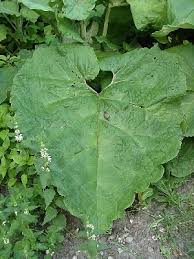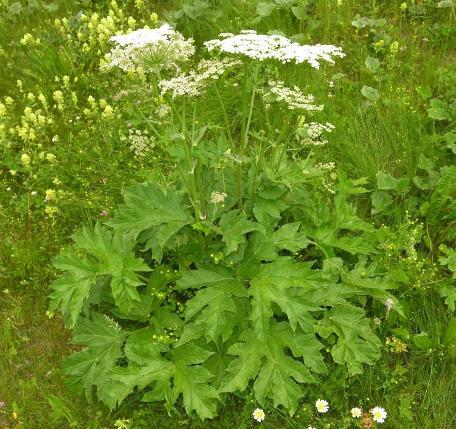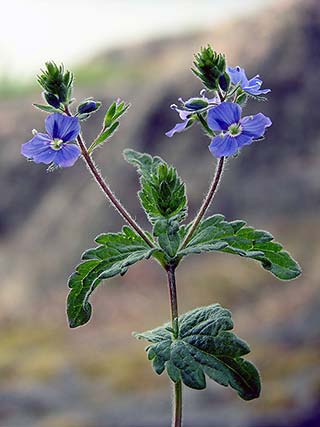Wildflowers in the Arboretum
Lesser Burdock Arctium Minus
Daisy Family: Asteraceae
Vernacular names: Louse-bur, Cuckoo-button, Wild Rhubarb, Clingers
Meaning: From Greek arction.
Habitat: waste ground, roadsides, open woodland, hedgebanks.
Flowers: July to September
Identification: Large triangular leaves with cordate base, dark green with felted or woolly undersides. Basal leaf stalks hollow. Flowers red-purple in globose heads, bracts (collectively known as the Involucre) with hooked tips, sticky to touch. Seed heads brown and stick readily to animals, clothing etc.
Similar Plant Species: Great Burdock and Wood Burdock
Associated species: Excellent nectar sources for many insects.
‘Mythology’: Originated the idea for Velcro. Some links to Fairies in Cornwall. Used for Burry Man Day in East Lothian 2nd Friday of August each year.
Food/medicinal use*: Not really known as a food source although roots can be boiled or fried as a vegetable. Dried roots used to treat skin diseases e.g. eczema. In Russia ‘Burdock Oil’ used as hair tonic and the Herbalist Culpeper wrote about the juice of leaves to treat snake bites.
*Please be sure you have the correct plant and that you are confident in its use – seek expert advice if unsure

Creeping/Spear Thistle Cirsium Arvense(CA)/Vulgare(CV)
Daisy Family: Asteraceae
Vernacular names: CA-Lettuce-from-hell, Field Thistle, Stinger Needles
CV – Bull Thistle, Scotch Thistle, Common Thistle
Meaning: From Greek Kirsion = Thistle or ‘swollen vein’. Arvense = of the field; Vulgare = common. Both from Latin.
Habitat: Grassland, waste ground, roadsides, farmland, open woodland. Nutrient-rich soils. Flowers: July to September/October.
Identification: CA- Leaves oblong/pinnatifid, wavy toothed edges, grey/green more curled looking with strong slender spines. Flowers mauve.
CV – Robust, dark green, long spear-like leaves with elongated terminal leaflet and yellow tipped stout spines. Flowers pink-purple.
Both known as Plume Thistles with seeds (Achenes) that have feathered hairs.
Similar Plant Species: Marsh Thistle – with continuously spiny winged hairy stem and often purple tinged.
Associated species: Excellent nectar sources for many insects – inc. Painted Lady butterflies and seeds sought after by birds such as Goldfinch and Linnet
Mythology: Spear Thistle believed to be the original National Emblem of Scotland.
Food/medicinal use*: Young stalks stripped and added to salads; hearts of flower heads treated like globe artichokes (removing bracts). Roots can be used but contain Inulin which is undigestible (can cause flatulence). Roots of CV used as poultice on sore jaws. Cherokees used pappus to fletch blowgun darts.
*Please be sure you have the correct plant and that you are confident in its use – seek expert advice if unsure.
Herb Robert Geranium robertianum
Geranium Family: Geraniaceae
Vernacular names: Bachelors Buttons, Granny-thread-the-needle, Stinking Robert, Red Robin
Meaning: From Greek Geranos – Crane. Probably named after an 11th Century French Monk (St Robert), who cured many people using the plant
Habitat: Woodlands, waste ground, walls, hedgerows, shady places
Flowers: from May to September (but plant around most of year)
Identification: Spreading annual/biennial plant with palmately lobed leaves and deeply cut leaflets (almost fern-like); sparsely hairy, bright green but stems and leaves develop reddish tinge. Acrid, mousy smell. Flowers small, 5 pink petals with darker lines (known as nectaries); each petal with claw shape below . Seed heads are long-beaked - like a cranes bill.
Similar Plant Species: Fairly easy to separate from other similar species
Associated species: Useful nectar source for many insects including bees , long-tongued hover flies, also one of food plants of Barred Carpet Moth larvae.
Mythology: Believed to be a plant of the house goblin Robin Goodfellow in England and similarly known in other countries
Food/medicinal use*: Fresh leaves can be eaten or made into tea. Rubbing fresh leaves on skin – the smell is said to repel mosquitoes. Used to treat nosebleeds/headaches amongst many other uses/curing capabilities.
*Please be sure you have the correct plant and that you are confident in its use – seek expert advice if unsure
Hogweed Heracleum Sphondylium

Carrot Family: Apiacaea (also known as Umbellifers)
Vernacular names: Limperscrimps, Cow Parsnip, Keck
Meaning: Named after Hercules; Sphondylium means vertebrate in reference to its ridged, segmented stem
Habitat: Prefers nutrient rich soils, found on woodland rides, hedgebanks, roadside verges and neutral grasslands (occasionally on calcareous grassland)
Flowers: from June to September
Identification: Robust plant with hollow, ridged coarsely hairy stem; leaves are once-pinnate with usually 5 broad triangular shaped leaflets (upper leaf stalks clasping the stem), and are coarsely toothed along margin. The creamy-white flowers are formed on an umbel (umbrella shape) with the actual flower heads on smaller umbels – these have bristle-like bracteoles whereas the main umbel has no bracts (modified leaf or scale).
Seeds are flat, oval – green turning brown when dried (similar to Parsnip seed)
Similar Plant Species: Giant Hogweed (Heracleum mantegazzianum) is an introduced species which grows up to 5metres with deeply lobed leaves and reddish-purple blotched stems (that Hogweed does not have) - a notifiable noxious weed and known for the sap causing blistering/scars to skin when exposed to sunlight.
Associated species: Beneficial to a wide range of insects as an excellent nectar source. Just stand and look at the flowers for a while to see how many different species visit.
Food/medicinal use*: Young leaves particularly can be used – before they fully open – cooked like spinach. Flower buds can be used like broccoli and the young shoots best blanched then cooked in butter (a bit like asparagus). Fresh seeds have a cardamom type taste.
Said to have been used as an aphrodisiac in Eastern Europe.
*Please be sure you have the correct plant and that you are confident in its use.
Garlic Mustard Alliaria petiolate
Cabbage Family: Brassicaceae (also known as Crucifers)
Vernacular names: Jack-by-the-Hedge, hedge Garlic, Sauce Alone
Meaning: Al-le-um from Latin for Garlic or Celtic all for pungent or burning. Petiolata means being stalked (stalk = petiole), so stalked garlic.
Habitat: A biennial plant that can be found in damp shaded areas such as hedgebanks, woodland edges (rides and glades), and other similar habitat.
Flowers: from April to June (leaves can appear as early as February)
Identification: Thin glossy, broadly heart-shaped, leaves with cordate base, bluntly toothed. Smell of garlic when crushed. Flowers in racemes (elongated flower stalk, on which the lowest flower first), clusters of four white petals in cross shape (as with many of the Cabbage family).
Associated species: Main food plant of Orange-Tip butterfly caterpillars as well as one of Green-veined white food plants. Garden Carpet moth,
Food/medicinal use*: Young leaves can be added to salad. In 17th and 18th centuries it was used as a flavouring in sauces with salt fish and lamb; in Wales records of its use with herrings. Contains a wide range of vitamins and minerals – high in A and C.
Seeds once used like snuff to cause sneezing; leaves as an antiseptic poultice on ulcers.
*Please be sure you have the correct plant and that you are confident in its use.
Germander Speedwell Veronica Chamaedrys

A low growing plant found in grasslands, woodland edges and hedge banks; flowers from April to July. Speedwells are now part of the Plantain family (Plantaginaceae).
The origins of its name are uncertain but chamaedrys means ‘charisma’ or ‘gift’ in Latin. Other vernacular names are Birds Eye; Farewell, goodbye.
A creeping plant with upright, ascending stems which have opposite rows of long white hairs, diagnostic of this plant (hold up to light and twist stem). The dark green leaves are triangular/oval, unstalked, opposite with coarse blunt teeth and hairy. Flowers are four-petalled on long stalks arising from leaf axils, bright blue with a white centre (hence its other name of Birds Eye). The lower petal is more often narrower than the rest. It can often be confused with Slender Speedwell.
Speedwells were thought to ‘speed you on your journey’ as a sign of good luck; in Ireland they were sometimes sown into clothing. The name Veronica is linked to St. Veronica who is believed to have wiped the sweat off the face of Jesus when he was on route to Calvary.
This plant is sometimes used as a tea infusion (from the leaves) – particularly in Austria, also said to be good for cramp and ulcers as well as being a blood purifier.
Other species include Field Speedwell, Wood Speedwell and Brooklime.
Lesser Celandine Ficaria verna (Ranunculus ficaria)
Other names include – Butter and Cheese, Pilewort*
One of the Buttercup family Ranunculaceae, (just about the largest plant family in the world) - from the Latin for frog (Rana). Other species include Marsh Marigold, Hellibores, Clematis and Anemones.
Early flowering species with a consistent average flowering date of 21st February, valuable nectar source for early insects such as Queen Bumble bees. Prefers damp soils in grassland, woodland and hedgebanks; very common, often carpeting areas.
Leaves glossy green, rounded/cordate (heart-shaped) in rosettes; flowers composed of 8 or more narrow yellow petals. Creeping stems, spreads mainly by rooting at nodes on stems or in some cases by bulbils – growths in axils of leaves that eventually fall off and new plants grow from these.
Celandine comes form the Greek word for Swallow (Chelidon) supposed to signify the coming of Spring; also known as ‘Spring messenger’ due to early flowering. High in Vitamin C, the young leaves can be eaten in salad although care needs to be taken as sap can cause contact dermatitis.
An unusual use of the petals and leaves in Cumbria was for cleaning teeth!
Not to be confused with the unrelated Greater Celandine which is part of the Poppy family.
*For treating of piles from the doctrine of signatures as bulbous roots said to resemble haemorrhoids.
Teasel Dipsacus fullonum
Vernacular names: Venus’s Basin, Brushes and Combs
Flowers: July to August
A biennial plant of the Teasel family – Dipsacaceae (normally seeds germinate one year and plant forms just leaves; second year: flowers, fruits and dies).
This is easily distinguishable with its spiky stem and conical flower heads. Below these is a calyx-like whorl of rigid, spiny bracts; the head also has stiff bracts that surround (known as an epicalyx) and are slightly longer than its pink/purple corollas (collective name for petals). The clusters of flowers first appear in the middle, often forming rings up and down the head.
The leaves in the first year form a basal rosette and are oblong to lanceolate with swollen prickles on the surface; in the second year when stem appears (can reach approx. 2 metres) the leaves are similar in shape but only have prickles on the underside midrib. They also form a cup at the base which collects water (see below).
Their name relates to the teasing out of wool fibres before spinning (known as carding) and raising the nap on fabrics. However, a cultivated variety was more often used in mills. In the 19th Century they were replaced with steel brushes. As mentioned, the water collected in the leaf cup, known as Teasel Water, was believed in the 17th century to remove freckles! In some places is said to still be used such as for relieving itchy eyes – but don’t try this at home.
Other members of the family are Small Teasel and Scabious with their globular heads and oval leaves.
Common (black) Knapweed Centaurea nigra
Vernacular names: Hard head, Paintbrush, Iron Knobs, Bachelor’s buttons
Flowers: July to September
One of the extensive Daisy (Asteraceae) family, this is one of our later flowering species. It has rough/hairy grooved stems with, more or less, unlobed linear leaves – also known as ‘entire’ leaves. Dull green.
The flower head has what is called an ‘involucre’ which consists of many small bracts (leaf-like structures that initially surround the developing florets) and this helps in identification. They are triangular in shape with brown tips. The flowers themselves, as with all of the Daisy family, consist of many individual florets (a composite head) and are mostly pink/purple – the outer florets can sometimes form a crown-like whorl. Looks a bit thistle-like.
Common in all sorts of grassland including road-verges, quite a hardy species.
John Clare (the 18th Century Poet) describes a Love-divination game where the picking of Knapweed florets is used – a bit like ‘he loves me, he loves me not’.
Also highly rated for its production of nectar – in the Top 5 of all plants.
Said to have once been used for healing ruptures, wounds, bruises and sores.
Lady's Bedstraw Gallium verum
This delicate looking plant is a member of the Bedstraw family (Rubiaceae), which have whorls of leaves along the stem – which is usually four-angled; small white or yellow flowers in clusters (Panicle).
Lady’s Bedstraw has creeping stems with whorls of 8-12 narrow dark green leaves, the margins of these are rolled back (rather than flat like it’s cousins), rough above , paler and hairy below. Small golden yellow flowers, on leafy panicles, that are ‘honey scented’. It does sometimes hybridise with Hedge Bedstraw. In flower from June to August.
It has the scent of new-mown hay when dried and would have been included in straw mattresses – especially in beds used by women giving birth. The scent of the dried flowers is said to act as a flea repellent. Also, once used to add colour to Double Gloucester cheese.
Another name for this plant is Lady’s Tresses.
Other members of the bedstraw family are Cleavers or Goosegrass (Gallium aparine), Hedge Bedstraw (Gallium mollugo) and Wild Madder (Rubia peregrina). Coffee plants are also related to the Bedstraws.
Yellow Rattle Rinanthus Minor
An intriguing plant – part of the Figwort family (Scrophulariaceae) that includes the likes of Speedwells (Veronica) and Foxgloves (Digitalis). Semi-parasitic on grasses and legumes, that is, it gains some of its nutrients from host plants but still photosynthesises. An important component of semi-natural grasslands as helps contain the more vigorous nature of some grasses, often allowing for more species-rich meadows.
Yellow Rattle has rough, sessile leaves (stalkless), that are lanceolate (lance shaped) with coarse blunt teeth, on black-spotted stems. Yellow flowers form on short spikes and are two-lipped – the upper lip is flattened with two short violet teeth and the lower lip is 3-lobed (divided but not completely separated). The calyx which consists of the sepals (outer set of leaf-like parts surrounding the petals) are very flattened, these turn brown and become inflated. In these the large seeds form and ‘Rattle’ hence the name of the plant. Flowers from May to August.
Other names for the plant are Hay Rattle, Rattlebaskets and Pots and Pans.
Cow Parsley Anthriscus sylvestris
A common plant found on most road verges, hedge banks and on woodland edges. Flowering from April to beginning of June.
A member of the ‘Umbellifers’ or Carrot Family (Apiaceae), who can mainly be identified by their flowers which form as an umbel – where the flowers are on stalks (pedicels) that all arise from the top of the main stem. With many of this family further rays arise from the end of these upon which the flowers form. At the base of the leaf-stalks are often sheaths that clasp the stem.
Quite easy to identify, Cow Parsley has fresh-green, fern-like leaves which are 2-3 times pinnate (known as a compound leaf)– where the leaf is divided into leaflets arranged along the stalk and these leaflets may also be divided into further leaflets, as in this case. The flowers are white with small leaf-like appendages at the base of the umbel called bracteoles. Stems and stalks are downy/hairy and hollow, without spots.
Another name for this plant is Queen Anne’s Lace with many explanations to it’s name such as to when she travelled the countryside in May where the roadsides were supposed to have been decorated for her; or that the leaves were said to resemble the lace patterns carried around by Queen Anne’s court ladies. Other interesting vernacular names are Grandpa’s pepper, Badman’s oatmeal or Rabbit meat. The term Cow Parsley is probably a reference to being an inferior version of real parsley.
It is related to the herb garden chervil and it’s young leaves can be mildly aromatic when crushed.
Similar species – Upright Hedge-parsley which has solid, rough stems; dull green, roughly hairy leaves and also has bracts (leaf-like appendages) at base of main umbel which are absent in Cow Parsley. Flowers July-August.